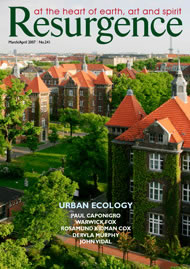OUR WORLD IS changing radically right under our very noses in ways that have never before been experienced by the human nervous system. In light of the enormity of these changes it might be a good idea to reflect on just how they may be affecting our lives.
My guess is that we have hardly been noticing. We have been too caught up in adapting to the new possibilities and challenges, learning to use the new technologies to get more done and get it done faster, and in the process becoming completely dependent on them, even addicted. And whether we realise it or not, we are being swept along in a current of time acceleration that shows no signs of slowing down. The technology, so touted to produce gains in efficiency and leisure, threatens to rob us of both if it hasn’t already done so. Who do you know who has more leisure?
It is said that the pace of our lives now is being driven by an inexorable exponential acceleration known as Moore’s law (after Intel founder Gordon Moore, who first stated it) governing the size and speed of integrated circuits. Every eighteen months, the computing power and speed of the next generation of microprocessors increase by a factor of two while their size decreases by a factor of two and their cost remains about the same. Think of it: increasing processing speed, greater and greater miniaturisation, and cheaper and cheaper electronics, with no end in sight. This combination proffers a seduction in computer systems for work and home, consumer products, games, and portable electronic devices that can easily lead to the loss of all sense of measure and direction as we respond willy-nilly to the increasing volumes of email, voice mail, faxes, pages and cell phone traffic coming in from all corners of the planet. True, much of what comes to us is from people we care about and with whom we want to stay connected. But what about balance, and how do we regulate the pace of instant and ubiquitous connectivity, and the expectations of instantaneous responding?
With our mobile phones and wireless palm devices, we are now able to be so connected that we can be in touch with anyone and everyone at any time, and do business anywhere. But have you noticed that, in the process, we run the risk of never being in touch with ourselves? In the overall seduction, we can easily forget that our primary connection to life is through our own interiority – the experiencing of our own body and all our senses, including the mind, which allow us to touch and be touched by the world, and to act appropriately in response to it. And for that, we need moments that are not filled with anything, in which we do not jump to get in one more phone call or send one more email, or plan one more event, or add to our to-do list. Moments of reflection, of mulling, of thinking things over, of thoughtfulness.
With all this talk about connectivity, what about connectivity to ourselves? Are we becoming so connected to everybody else that we are never where we actually are? We are at the beach on the cell phone, so are we there? We are walking down the street on the cell phone, so are we there? We are driving on the cell phone, so are we there? Do we have to let the possibility of being in our life go out the window in the face of the speedup in our pace of life and the possibilities for instant connection?
What about not connecting with anyone in our ‘in-between’ moments? What about realising that there are actually no in-between moments at all? What about calling ourselves up for a change, checking in and seeing what we are up to? What about just being in touch with how we are feeling, even in those moments that we may be feeling numb, or overwhelmed, or bored, or disjointed, or anxious or depressed, or needing to get one more thing done?
What about being connected to our bodies, and to the universe of sensations through which we sense and know the outer landscape? What about lingering for more than the most mindless and automatic of moments with awareness of whatever is arising in any particular moment in the mind: our emotions and moods, our feelings, our thoughts, our beliefs? What about cultivating a bigger picture that includes ourselves on any and every level, even if the picture is always a work in progress, always tentative, always changing, always emerging or failing to emerge, sometimes with clarity, sometimes not?
Much of the time, our newfound technological connectivity serves no real purpose, just habit, and pushes the bounds of absurdity as with the commuters all stuck to their mobiles informing their family and friends, “I’m getting on the train now.”
What is wrong with just getting on the train without that piece of information being communicated?
If we were telling ourselves, it might just be a mindful noting of our experience, and therefore quite useful in cultivating awareness of embodied experience unfolding in the present moment. I am getting on the train (and knowing it). I am getting off the train (and knowing it). That is embodied wakefulness. Tell someone else? Who needs it? It can annihilate the moment through distraction, diversion and reification. Somehow, being alone in and with our experience is no longer deemed sufficient, even though it is our life in that moment.
THIS IS NOT to say that much of the technology we are developing is not extremely useful. Cell phones allow parents to stay in touch with their children. Mobile phones allow us to find each other and to co-ordinate our activities in useful ways. Computers and printers and their powerful software capabilities, coupled with the capacity to exchange documents instantly by email anywhere and everywhere and access information instantly, allow us to get more work done in a day than we might have got done in a week or even a month fifteen years ago. I am not by any stretch of the imagination advocating a Luddite-like condemnation of technological development and romantically wishing to turn the clock back to a simpler age. But I do think it is important for us to be mindful of all the new and increasingly powerful ways available to us through which we can and will be able to lose ourselves in the outer and forget about the inner and become even more out of touch with ourselves.
The more we are entrained into the outer world in all these new and increasingly rapid ways that our nervous system has never before encountered, the more important it may be for us to develop a robust counterbalance of the inner world: one that calms and tunes the nervous system and puts it in the service of living wisely, both for ourselves and for others. This counterbalance can be cultivated by bringing greater mindfulness to the body, to the mind, and to our experiences at the interface between outer and inner, including the very moments in which we are using the technology to stay connected, or in which the impulse to do so is arising. Otherwise, we may wind up at very high risk of living robotic lives, where we no longer even have time to contemplate who is doing all this doing, who is getting somewhere more desirable, and is it really a better place to be?
From Coming to Our Senses: Healing Ourselves and the World Through Mindfulness © Jon Kabat-Zinn 2005 (Hyperion).








